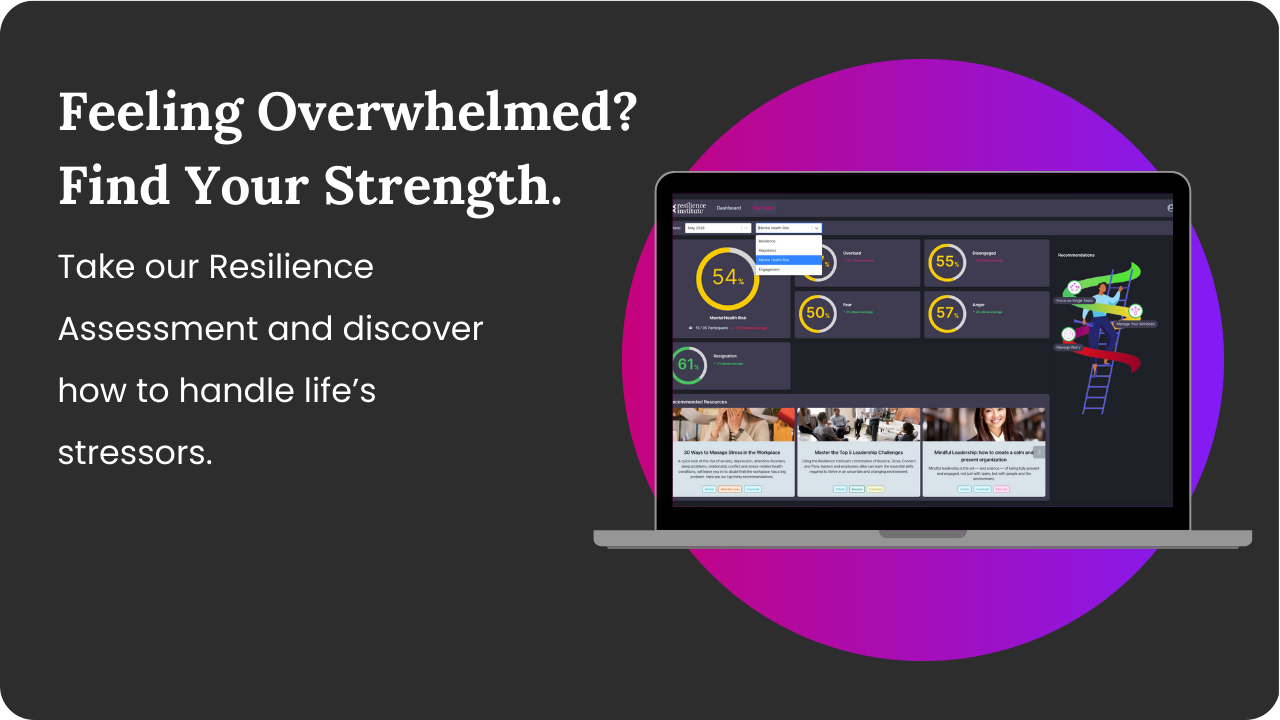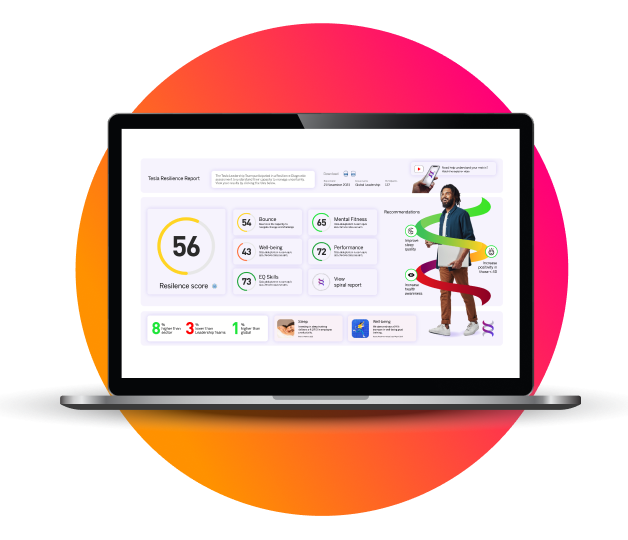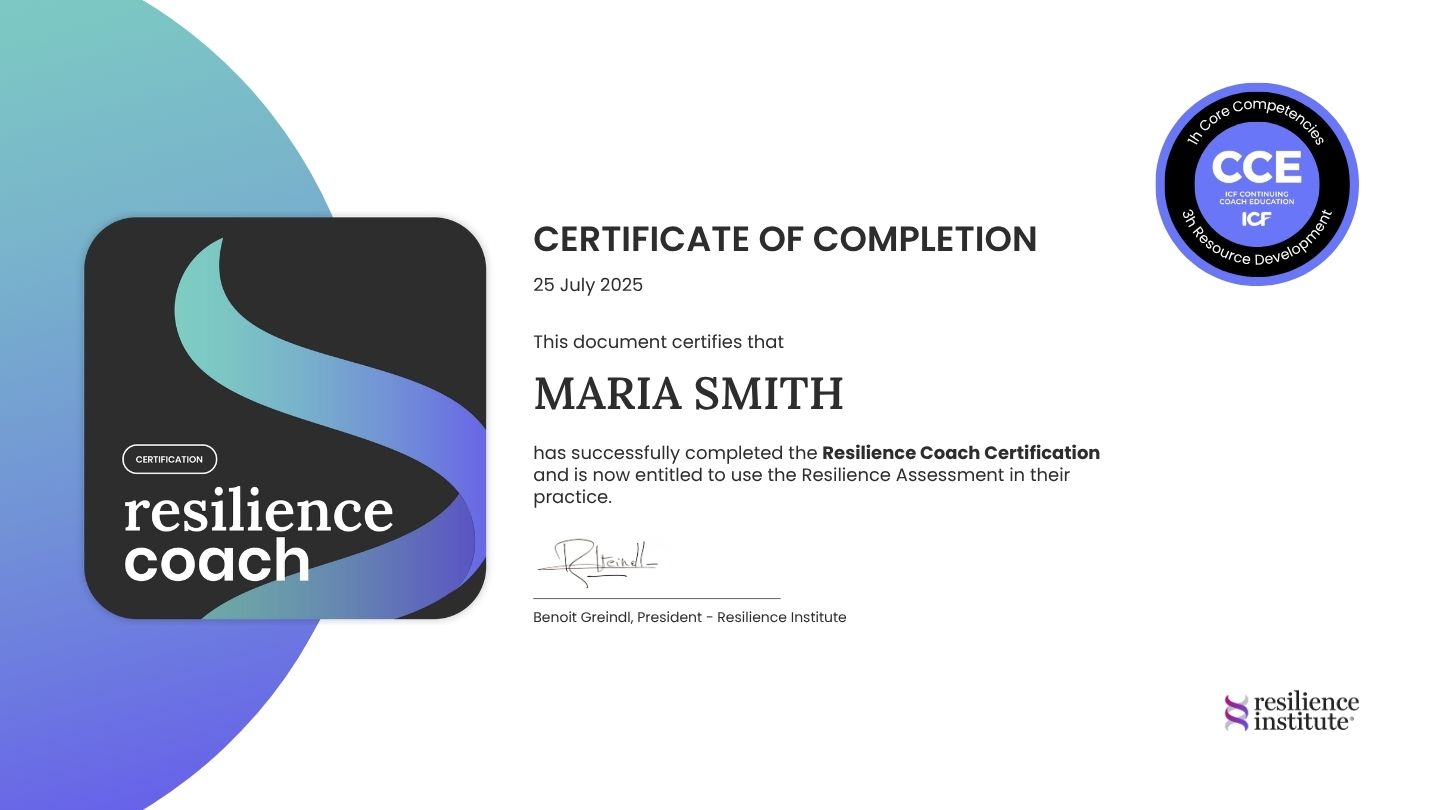
A Guide to Measuring Resilience
Resilience gives you the strength and courage to continue your journey despite setbacks or unmet expectations. Research indicates that higher levels of resilience correlate with better outcomes when navigating a crisis, managing an illness or chronic pain, and improving physical and mental health. A 2020 Forbes article showed that resilience training reduced the average depression symptoms by 33-44%.
For organizations, resilience means having a stronger team capable of achieving against the odds and weathering change, challenges, and economic storms. As the world shifts further into choppy waters, resilience is the key to your organization staying its course. And, as the saying goes, what is measured is managed. Thankfully, measuring resilience is not only possible but is an effective way to understand the human risks and strengths within a team and an organization. Looking further ahead, it’s the starting block for building a more resilient and adaptable workforce.
Want to measure your resilience? The Resilience Assessment is a peer-reviewed, psychometrically valid toolkit used by hundreds of thousands of participants worldwide.

What is resilience? Can you measure it?
Resilience is the ability to bounce back after facing a challenging situation without letting adversity affect one’s chances of future happiness or success.
While some people continue to thrive, facing a challenging period of their lives with the confidence that things will get better, others struggle under pressure. From the outside, it can be challenging to grasp what separates these two prevalent but opposite reactions. This is the result of resilience in action.
There is an essential distinction between repression and resilience; resilient people are still likely to be shaken by challenging events. However, they view these events as opportunities for growth. They change their direction and build a new positive path forward, incorporating the challenging situation into a new sense of self and reconsidering priorities.
Resilience research suggests six areas in which resilience can be seen in an individual’s life. These include reframing, using the power of positive emotions, using the power of positive emotions, exercising, engaging in trusted social networks, identifying signature strengths, and being optimistic.
Reframing
An essential aspect of resilience is reframing a challenging situation and developing a refreshed, more constructive, and beneficial perspective. By reframing a problematic situation, an individual can better cope without feeling stuck.
Using the power of positive emotions
Accessing positive emotions even following challenging times is an essential component of resilience. Positive emotions can help us face the problems in our lives while considering solutions to move forward. They also encourage us to connect with others and give us an overall sense of purpose and fulfillment.
Taking part in physical activities
The benefits of exercise are well-established for physical health, but physical activity also does wonders for mental health. By participating in physical activity, individuals can mitigate stress and build a new sense of self-respect and self-worth.
Engaging in trusted social networks regularly
Spending quality time with friends, work pals, and family members can help alleviate the loneliness of challenging situations. In addition, conversations with others about what’s going on can help to take some of the pressure off and help to gain a more holistic view of the situation.
Identifying and utilizing signature strengths
Continuing to recognize strengths despite challenging times is a critical component of resilience. By utilizing strengths, individuals can feel a boost in control and meaning in their lives and take on new responsibilities and challenges.
Being optimistic about the future
A general sense of optimism towards the future is another sign of resilience. Individuals with strong resilience will view challenges or setbacks as temporary, knowing their future path isn’t permanently negative. This outlook can help maintain a hopeful perspective towards the future.
Resilience Assessments: Why are they important?
Resilience tests, also known as scales, examine an individual’s resilience across key areas. Usually, this test is conducted using a questionnaire, which collects information and responses from individuals about how they adapt to difficulties.
Resilience assessments are essential because they help to identify areas of strength and areas where improvement may be needed. This can be beneficial individually and for a business, as it can identify weaknesses and strengths within a company. Resilience assessments can also promote awareness, leading to more effective intervention use.
How do we measure resilience?
Resilience is a complex psychological phenomenon that can be classified by a person’s ability to continue to cope with and recover from adversity. Several assessments or scales have been created in the last 30 years to help researchers, employers, therapists, and even private individuals better understand how resilience functions and, more importantly, how it can be quantified. These different frameworks are primarily conducted via surveys and questionnaires that assess a person’s mindset, coping strategies, and broader support network.
Different tools can be employed in various situations. For example, the Academic Resilience Scale was specifically designed to assess students. While the Resilience Scale for Adults is best utilized when assessing grown adults. The Resilience Diagnostic Assessment, on the other hand, is primarily employed by organizations looking to improve their resilience as a whole. By using these tools, organizations can better understand their ability to handle stress and setbacks while also understanding where points of weakness may lie. Below are several tools and frameworks that can help your business better understand its quantifiable resilience score.
Resilience Assessment
The Resilience Assessment is developed and updated by the Resilience Institute. Recently releasing V5 of this comprehensive tool, the Resilience Institute continues to help businesses and organizations quickly and comprehensively assess their staff and management’s well-being, effectiveness, and resilience.
The diagnostic assessment covers 50 factors within 5-8 minutes, looking at mental health, stress management, well-being, emotional intelligence, and more. Based on peer-reviewed psychometrics, the assessment features 11 categories labeled as strength or risk based on a respondent’s results. One of the benefits of choosing the Resilience Assessment is that it is presented alongside a wealth of interactive resilience training & coaching for individuals and organizations. This means there is a direct way to go beyond measurement towards actively engaging with improving resilience. So, if you’re interested in assessing your organization’s resilience, this is an effective and convenient tool.

Connor-Davidson Resilience Scale
Dr Kathryn Connor and Dr Jonathon Davidson developed the Connor-Davidson Resilience Scale (DC-RISC). It’s a widely adopted assessment designed to help measure resilience in individuals. The scale consists of 25 items, each rated on a five-point scale. These items focus on several areas of resilience, including personal competence, adaptability, tolerance of negative affect, and more. This tool has been used across many cultures and diverse populations, making it a reliable and effective method for measuring resilience.
Predictive 6-Factor Resilience Scale
This innovative assessment tool, the Predictive 6-Factor Resilience Scale (PR6), measures a person’s resilience based on six factors. The PR6 offers a unique approach to understanding resilience, considering several factors contributing to someone’s ability to experience a setback and cope positively. The PR6 assesses self-regulation, optimism, adaptive coping, supportive relationships, and more. Many physicians and therapists use this set of tools to predict resilience in their clients.
Resilience Scale for Adults
The Resilience Scale For Adults (RSA) is a well-established tool for assessing and evaluating resilience, specifically in the adult population. Developed in Norway, the RSA looks at six core dimensions of resilience: perception of self, perception of the future, social competence, family cohesion, and social support. The RSA aims to establish a comprehensive understanding of a person’s resilience and has also been used successfully in clinical practices.
How to improve resilience?
Resilience is a skill that can be cultivated over time by implementing specific strategies into your daily life. If you are looking for ways to improve your resilience, then consider incorporating some of the below methods:
- Work on having a positive mindset—Having a positive outlook on life can be immensely beneficial for your everyday life. Still, it is also a direct path to helping build resilience. Stopping negative self-talk and adjusting to a positive mindset can take time, so be patient. Mindfulness activities and meditation can help monitor negative self-talk and move toward a more positive outlook.
- Grow a strong support network — A social circle is essential to resilience. Making an effort to maintain relationships with friends and family members can help individuals cope with adversity. Friends can help by providing support, advice, and positivity in challenging periods.
- Introduce self-care routines—Practising self-care can help improve resilience. Self-care includes taking care of yourself in all key areas, including sleeping well, exercising regularly, eating a healthy diet, and implementing stress-minimizing techniques like meditation or yoga. Self-care practices can also help individuals overcome self-esteem issues and low confidence.
- Learning from the past — By learning from the past and reflecting on past coping methods that have worked or not worked, individuals can work on new strategies for successfully coping in the future.
- Seeking help—Everyone needs help sometimes; there’s no shame in reaching out and getting help when needed. Many professional help sources, such as psychology, can help individuals get back on track. Alternatively, reaching out to friends for extra support can be beneficial.
Conclusion
Resilience is an essential aspect of the human experience, and our ability to navigate negative changes and recover from adversity can significantly impact our lives. So, measuring and assessing resilience is the first step in improving our ability to handle life’s challenges. On an organizational level, this can significantly impact a business’s ability to weather downturns and right the ship when needed. Ultimately, by quantifying resilience, using the tools and psychological scales available, we can understand how to improve it and make a difference in our personal and work lives.

